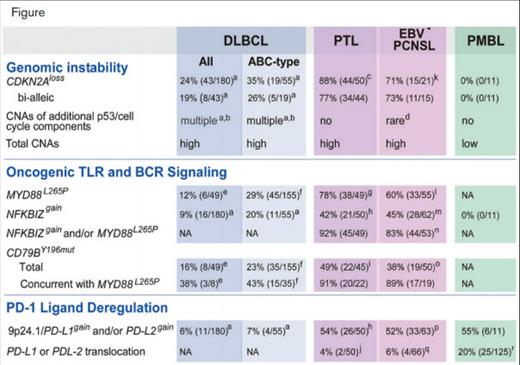Lymphoma involving the central nervous system (CNS) and the testes has long posed a therapeutic challenge given the paucity of active systemic chemotherapy achieving pharmacologic levels in these sanctuary sites. Since the 1950s, methotrexate has been used as an antineoplastic drug, and high-dose methotrexate remains the cornerstone of treatment for CNS lymphoma, although durable remission is extremely rare. As the majority of patients affected by recurrent primary CNS lymphoma (PCNSL) and primary testicular lymphoma (PTL) are elderly and not appropriate candidates for high-dose chemotherapy with stem cell rescue, novel therapeutic approaches for these diseases are desperately needed.
Dr. Bjoern Chapuy and colleagues recently performed a comprehensive analysis of the genetic features of PCNSL (Epstein Barr virus negative) and PTL. By analyzing copy number alterations, chromosomal rearrangements, and recurrent somatic mutations, the authors described a genetic signature of the two diseases, clearly distinct from that of primary mediastinal B-cell lymphoma (PMBL) and diffuse large B-cell lymphoma (DLBCL). Their findings establish a basis for clinical investigation of novel targeted approaches.
Overall, PCNSL and PTL have a unique set of abnormalities characterized by genomic instability, abnormal signaling through the Toll-like receptor (TLR)-- often in combination with activation of the B-cell receptor (BCR) pathway, and upregulation of programed cell death-1 (PD-1) ligands. Unlike DLBCL, in which p53 and related cell cycle proteins are dysregulated, frequent copy number alterations were found, including bi-allelic loss of CDKN2A, which lies upstream of p53. In terms of mutations, nearly all cases of both PCNSL and PTL harbored MYD88 L265P mutations. MYD88 is a protein used by TLRs to activate transcription through NF-κB. This mutation is found in the vast majority of cases of Waldenström macroglobulinemia and in approximately 30 percent of the activated B-cell subtype of DLBCL. Copy gains of NFKBIZ, which also regulates NF-κB signaling, were frequently identified, as were alterations in the B-cell receptor component CD79B. Lastly, copy gains of 9p24.1, which includes the genes for programmed death-ligands 1 and 2 (PDL1 and PDL2) were found in more than 50 percent of cases of PCNSL and PTL.
Unique Combinations of Structure Alterations in Discrete LBCL Subtypes. The table notes frequency of specific genetic alterations modulating “genomic instability,” “oncogenic TLR and BCR signaling,” and “PD-1 ligand deregulation” in all DLBCL, ABC-type DLBCL, PTL, EBV PCNSL, and PMBL. Used with permission.
Unique Combinations of Structure Alterations in Discrete LBCL Subtypes. The table notes frequency of specific genetic alterations modulating “genomic instability,” “oncogenic TLR and BCR signaling,” and “PD-1 ligand deregulation” in all DLBCL, ABC-type DLBCL, PTL, EBV PCNSL, and PMBL. Used with permission.
In Brief
These findings provide insight into oncogenic pathways in primary CNS lymphoma and primary testicular lymphoma that are unique compared with other subtypes of DLBCL. PD-1 inhibitors are being actively being studied in Hodgkin lymphoma as well as multiple subtypes of non-Hodgkin lymphoma. Studies in other tumor types suggest that these drugs have activity in primary and secondary tumors involving the CNS, including melanoma and glioblastoma. Therefore, evaluation of these agents in PCNSL and PTL is warranted. Additionally, IMO-8400, an antagonist to TLR 7, 8, and 9, is currently being evaluated in MYD88L265P-mutated DLBCL. Whether these agents will have activity in PCNSL and PTL is yet to be determined, but rational approaches based on this work provide hope for improving treatment beyond high-dose chemotherapy.
Competing Interests
Dr. LaCasce indicated no relevant conflicts of interest.

